How to Ensure Longevity and Reliability with a High-Quality Membrane Switch
How to Ensure Longevity and Reliability with a High-Quality Membrane Switch
Blog Article
Just How Membrane Layer Switches Add To the Longevity of Electronic Control Panels
Membrane layer buttons play a critical duty in enhancing the resilience of digital control panels, largely through their multi-layered construction which supplies efficient security versus environmental aspects such as moisture and dirt. The absence of moving parts dramatically minimizes the chance of mechanical failures, making membrane changes perfect for demanding applications.
Meaning of Membrane Layer Switches

Membrane layer switches are developed to be slim and lightweight, making them suitable for applications where space is limited. They can be made in various forms, dimensions, and shades, providing versatility in layout that meets aesthetic and functional demands. Furthermore, membrane layer buttons can incorporate various innovations, such as responsive feedback and LED signs, improving individual experience.
As a result of their building and construction, membrane layer buttons are frequently resistant to dust, moisture, and basic wear, adding to their sturdiness in requiring environments. Their seamless design not just promotes very easy cleaning but also minimizes the risk of mechanical failure, making them a favored option for makers seeking trustworthy interface in their electronic control panels.
Defense Versus Ecological Elements
The style of membrane changes inherently provides a level of defense versus various environmental variables, which is important for preserving functionality in tough conditions - Membrane Switch. These buttons are normally constructed with layers of versatile materials that protect inner elements from wetness, dust, and impurities. By enveloping the circuitry, membrane layer changes lessen the risk of short circuits and rust, which can substantially hinder efficiency
In addition, making use of robust adhesives and sealants throughout production enhances their resistance to ecological obstacles. Membrane layer switches can sustain exposure to chemicals and solvents, making them ideal for sectors such as food handling and healthcare, where hygiene and cleanliness are paramount. Their seamless surface area design also stops the build-up of dust and germs, facilitating easier cleaning and upkeep.
Temperature fluctuations are an additional ecological concern, and membrane buttons are engineered to function successfully throughout a large range of temperatures (Membrane Switch). This flexibility guarantees that control board remain operational in numerous setups, from industrial atmospheres to customer electronics
Effect On User Interaction
User communication with digital control board is significantly affected by the layout and capability of membrane layer buttons. These switches offer a tactile interface that boosts the total user experience, enabling user-friendly navigation and control. Their receptive nature guarantees that customers receive instant comments upon activation, which is critical for jobs requiring precision and efficiency.
Additionally, the smooth surface area of membrane layer switches over promotes very easy cleaning and upkeep, advertising customer self-confidence in the integrity of the interface. This cleanliness is especially crucial in atmospheres where hygiene is paramount, such as medical or food handling settings. Furthermore, the compact and light-weight layout of membrane layer switches over adds to the visual charm of control board, motivating individual involvement with a contemporary and sleek look.
Additionally, the integration of visual aspects, such as printed icons and backlighting, assists customers Visit This Link quickly identify features, minimizing the discovering curve related to new devices. Therefore, users can run gadgets better, leading to boosted productivity and fulfillment. In summary, membrane layer buttons play an essential duty in enhancing user communication by combining capability, aesthetics, and ease of use, eventually bring about enhanced operational performance.
Layout Versatility and Modification
Design flexibility and customization are important facets of membrane layer switches, More Bonuses enabling manufacturers to customize electronic control board to certain applications and user needs. This flexibility permits the combination of different design elements, such as shades, graphics, and appearances, which can enhance the aesthetic charm and user interaction of the control panel.
Membrane buttons can be personalized in shapes and size, fitting a large range of devices and applications, from industrial equipment to customer electronics. This adaptability ensures that makers can develop intuitive user interfaces that align with individual assumptions and functional requirements. Furthermore, the capability to incorporate one-of-a-kind attributes such as backlighting or responsive responses better improves functionality, permitting a much more interactive experience.
Furthermore, the production procedure for membrane layer changes sustains the rapid prototyping of designs, making it possible for manufacturers to iterate and improve their principles swiftly. This capacity not just speeds up the growth timeline but also guarantees that the end product satisfies particular useful and visual criteria.

Cost-Effectiveness and Long Life
Cost-effectiveness and durability are Get More Information considerable benefits of membrane switches, making them an attractive alternative for suppliers and end-users alike. These buttons are typically less costly to create than traditional mechanical buttons, largely because of their simplified manufacturing procedures and the minimized number of components called for. This expense benefit prolongs not just to initial manufacturing but likewise to long-term operational expenditures, as membrane layer switches often call for less upkeep and have a reduced failure rate.
In addition, the durability of membrane layer switches adds to their total value. Constructed from long lasting materials, they are immune to ecological aspects such as dampness, dust, and chemicals, which can cause early wear in other button types. The lack of moving components lessens mechanical failing, enabling membrane changes to maintain performance over extended periods.
This durability is specifically helpful in applications requiring constant efficiency under requiring problems, such as medical tools and industrial devices. Inevitably, the combination of cost-effectiveness and longevity makes membrane changes an economically viable selection for manufacturers, providing trustworthy options that hold up against the examination of time while optimizing monetary considerations.
Verdict
Finally, membrane layer switches substantially improve the toughness of electronic control board via their durable construction and protective functions. By properly securing circuitry from environmental threats and reducing the danger of mechanical failing, these buttons make certain consistent performance popular applications. The seamless style promotes hygiene and ease of maintenance, while customization options allow tailored solutions for various requirements. On the whole, membrane layer changes stand for a reputable and cost-effective selection for boosting the long life and capability of digital control systems.
Report this page